Canon EF-M 18-150mm f/3.5-6.3 IS STM Review
-
Ease
of Use -
Sample
Images -
Lens
Specs -
Rating &
Conclusion -
Main
Rivals -
Review
Roundup - Comment
-
More…

Introduction
The new Canon EF-M 18-150mm f/3.5-6.3 IS STM lens is being marketed as the ideal ‘all-in-one’ lens for uses of the EOS M system. You can buy it as part of the kit with the newly launched EOS M5 compact system camera. It offers an equivalent focal length of 29-240mm (remembering that the APS-C format of EOS M camera is a 1.6x crop). The Canon EF-M 18-150mm f/3.5-6.3 IS STM lens is constructed of 17 elements in 13 groups, and there are 7 diaphragm blades. An image stabiliser offers 4 stops of compensation, and the lens uses an STM AF motor. The closest focusing distance is 0.25m at 18-50mm, or 0.45m at 150mm. The maximum magnification of 0.31 is available at 150mm. If you want to buy the Canon EF-M 18-150mm f/3.5-6.3 IS STM lens separately from the EOS M5 camera, you can purchase it for around £429 / $499.
Ease of Use
The Canon EF-M 18-150mm f/3.5-6.3 IS STM lens is available in two colours, black, and the silver version we were supplied with. Only the outer of the lens is silver, if you twist it to zoom the lens, you’ll see that the inside is black.
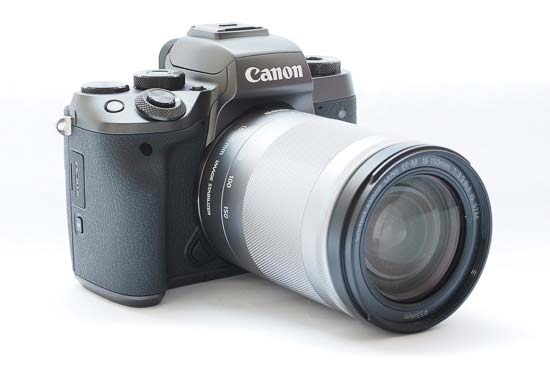 The Canon EF-M 18-150mm f/3.5-6.3 IS STM lens mounted on the EOS M5 camera
The Canon EF-M 18-150mm f/3.5-6.3 IS STM lens mounted on the EOS M5 camera
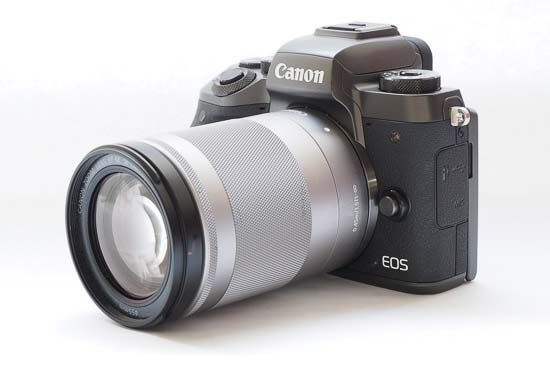 The Canon EF-M 18-150mm f/3.5-6.3 IS STM lens mounted on the EOS M5 camera
The Canon EF-M 18-150mm f/3.5-6.3 IS STM lens mounted on the EOS M5 camera
There are two rings around the lens, the large ring in the middle of the lens allows you to zoom the lens in and out. This portion of the lens is textured so you can easily find it. Zooming in and out is quick and fluid - but it’s slow enough to feel measured, and like you’re not going to accidentally move the lens too far one way or the other when you don’t want to.
The second ring is in front of the zoom ring, and is a much thinner ring. Half of the ring is covered with a texture, so you’ll find that you can identify it easily by touch - feel for the smooth part immediately followed by texture after the zoom ring. The focusing ring only comes into action when you’re using manual focus - something you will have to select on-camera as there’s no switch or button to switch from AF to MF on the lens itself.
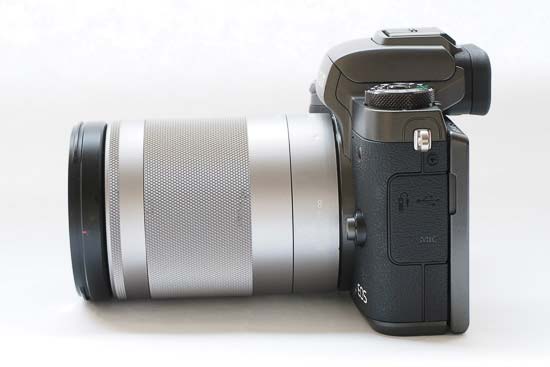 Side of the Canon EF-M 18-150mm f/3.5-6.3 IS STM lens
Side of the Canon EF-M 18-150mm f/3.5-6.3 IS STM lens
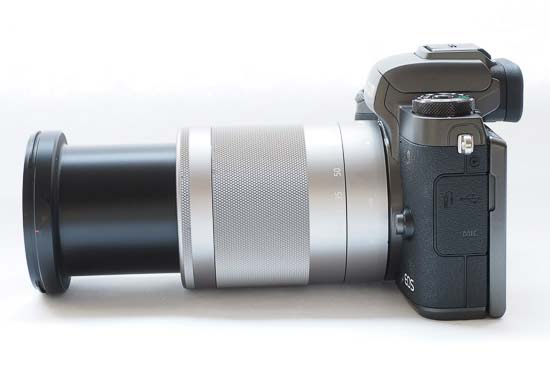 Side of the Canon EF-M 18-150mm f/3.5-6.3 IS STM lens, extended to 150mm
Side of the Canon EF-M 18-150mm f/3.5-6.3 IS STM lens, extended to 150mm
In terms of markings on the Canon EF-M 18-150mm f/3.5-6.3 IS STM lens, there is a white dot which you line up with the white dot on the lens mount to correctly attach it to the camera. There are also markings for the various focal lengths the camera offers. It starts from 18, the widest point, and has markings for 24, 35, 50, 70, 100 and 150mm - these are actual focal lengths, not equivalent focal lengths.
 Side of the Canon EF-M 18-150mm f/3.5-6.3 IS STM lens
Side of the Canon EF-M 18-150mm f/3.5-6.3 IS STM lens
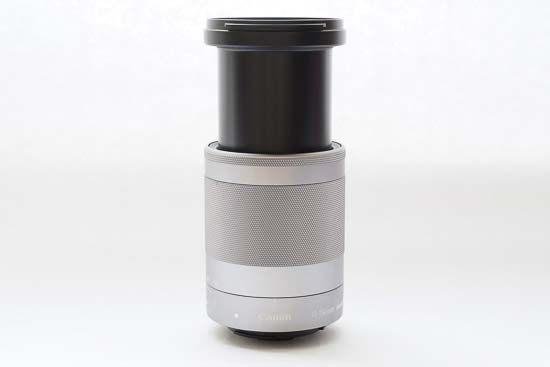 Side of the Canon EF-M 18-150mm f/3.5-6.3 IS STM lens, extended to 150mm
Side of the Canon EF-M 18-150mm f/3.5-6.3 IS STM lens, extended to 150mm
We have been using the 18-150mm lens in conjunction with the EOS M5 - a camera which seems particularly well suited to the larger size of the lens. With the lens attached, the camera still feels reasonably well balanced, if a tiny bit front heavy.
One thing to note about using the lens with the EOS M5 though is that the lens barrel is in the way of the flash, so you may find at certain angles that a shadow is created by it.
 Front of the Canon EF-M 18-150mm f/3.5-6.3 IS STM lens, extended
Front of the Canon EF-M 18-150mm f/3.5-6.3 IS STM lens, extended
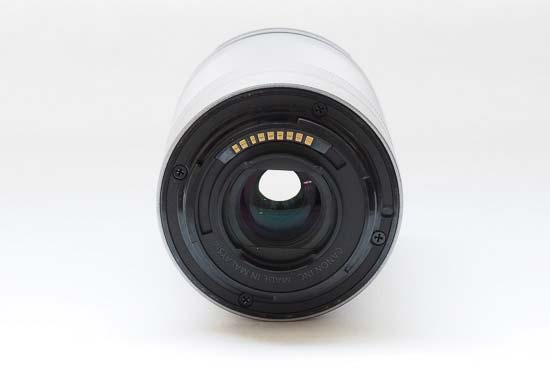 Rear of the Canon EF-M 18-150mm f/3.5-6.3 IS STM lens
Rear of the Canon EF-M 18-150mm f/3.5-6.3 IS STM lens
The Canon EF-M 18-150mm f/3.5-6.3 IS STM lens has a 55mm thread, and you can buy a Lens Hood EW-60F to fit on the end of the lens - it’s a shame that it doesn’t come in the box already.
Weighing in at 300g, the Canon EF-M 18-150mm f/3.5-6.3 IS STM lens has enough of a weight to feel quality, but is light enough so as not to weigh down the camera, or tip the balance if you’re shooting one-handed.
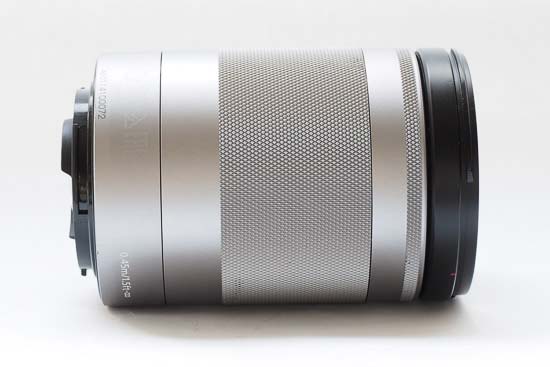 Side of the Canon EF-M 18-150mm f/3.5-6.3 IS STM lens
Side of the Canon EF-M 18-150mm f/3.5-6.3 IS STM lens
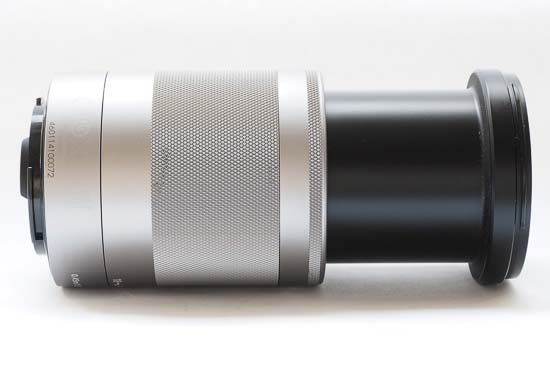 Side of the Canon EF-M 18-150mm f/3.5-6.3 IS STM lens, extended to 150mm
Side of the Canon EF-M 18-150mm f/3.5-6.3 IS STM lens, extended to 150mm
Focal Range
At 18mm you get an angle of view of 74 degrees.
 Field of view at 18mm
Field of view at 18mm
At the full zoom of 200mm, the angle of view is 10 degrees.
 Field of view at 150mm
Field of view at 150mm
Focusing
The Canon EF-M 18-150mm f/3.5-6.3 IS STM lens is good at focusing in a variety of different conditions, almost always locking onto the subject with relative ease. However, if the light is particularly low, you may find that the camera struggles if there’s low contrast. If you try to focus too close to the subject, the lens will attempt to focus, but will almost always display a red rectangle around the focusing area on the screen of the camera.
Chromatic Aberrations
The Canon EF-M 18-150mm f/3.5-6.3 IS STM lens shows excellent resistance to chromatic aberrations - I have struggled to find any obvious examples, even when examining high contrast areas of an image at 100%.
 |
 |
Light Fall-off
Shooting at the widest point of 18mm, you can see that at the widest aperture of f/3.5 then there is some light drop off in the corners of the image. The effect is lessened by the time you move to f/4.0, and is pretty much non-existent at f/5.6
The other focal lengths have different maximum apertures. At the longest focal length of 150mm, it’s only possible to go as wide as f/6.3. At this aperture setting at this length there’s almost no light drop off, or it’s certainly not enough to be bothersome in most shooting conditions.
Vignetting is a lot more pronounced across the whole focal length range when you look at the raw format files compared with the JPEG images - that is because images haven’t had any lens correction applied to them.
 Vignetting at 18mm
Vignetting at 18mm
 Vignetting at 150mm
Vignetting at 150mm
Distortion
At the wider focal lengths, such as 18mm and 28mm, you can see some slight distortion when shooting geometric subjects which make it obvious. If you get too close to a normal subject, you can expect to see some distortion at wide angle lengths.
 Distortion at 18mm
Distortion at 18mm
 Distortion at 55mm
Distortion at 55mm
Macro
The minimum focusing distance of the Canon EF-M 18-150mm f/3.5-6.3 IS STM lens depends on the focal length you’re using it at. At 18-50mm, you can close as 0.25mm, but that rises to 0.45mm when shooting at 150mm. If you don’t have a dedicated macro lens, you may want to consider using this, but remember that the maximum magnification is 0.31x - which is at the telephoto end of the lens, and where you are likely to get the best macro results possible from the lens.
 Close-up performance
Close-up performance
Bokeh
As a superzoom lens, the Canon EF-M 18-150mm f/3.5-6.3 IS STM doesn’t have a particularly wide aperture available, but it is still capable of creating shallow depth of field effects which are attractive. Bokeh is generally well produced and smooth - you can judge yourself from the pictures below.
 |
 |
 |
 |
Sharpness
In order to show you how sharp this lens is, we are providing 100% crops on the following pages.
-
Ease
of Use -
Sample
Images -
Lens
Specs -
Rating &
Conclusion -
Main
Rivals -
Review
Roundup - Comment
